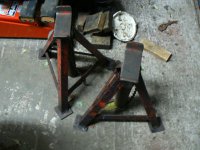With MOTs due on four of the "family fleet" by the end of March and Mrs J now returned to me from her unexpected stay in hospital - she's taking things very quietly for a while - I've been working my way through our Panda and Ibiza to leave time for the boys to leave their cars when convenient to them.
The Ibiza, being so new (coming up on 4 years and 18,000 miles) is, as you would expect, needing little more than a good service and a bit of "fettling". She's already giving up a few "intimate" secrets though, like the air filter having two "pop" on/off rubber grommets underneath where you can't see them! The effect is that they make it feel as if, despite having removed all the fixings, it - the filter casing - still doesn't want to come off. You have to be brave and give it an almighty tug! Now much easier after a light application of silicon grease!
My preferred local factor (SRS) is now supplying Mahle filtration products as well as the Comline they've been doing for some time. I'm very pleased about this and will be using the Mahle filters from now on.
Yesterday I started on Becky (our Panda). The service went well and I was pleased to see that the "dampness" under the rear wheel cylinder dust rubbers has not got any worse. I've already bought new cylinders but as I'm going to have to do pipes as well I'm just hoping it'll all last until the better weather comes. Then, service complete, I went looking for the "clunk" her front suspension has been making for the last couple of weeks. I was suspecting it to be due to an anti roll bar drop link ball joint and she didn't disappoint me. The diagnostic give away was that it clonked most loudly when either front wheel went over a bump, pot hole, etc on it's own but not so much when both wheels went over a bump together (like a "sleeping policeman" for instance). So, right enough, Front end up in the air, - you need to get both front wheel up in the air otherwise, if you just jack up one wheel, the anti roll bar will exert force on the drop links and you won't be able to feel any play in the joints - and there it was O/S/F drop link bottom joint with play in it when you give it a wiggle.
As I was lying on my back thinking "the thread on the bottom bolt looks mighty rusty, might have to take the angle grinder to it" It flashed through mind that, from time to time, people have posted asking how best to support their car whilst working on it. So I thought You might like to see how I support Becky?
I'm fortunate in that I have a nice big trolley jack and I've made up a couple of jacking pads which allow the load to be spread on the sill panels. Still always listen carefully for "crackling" noises and sill deformation during jacking though.
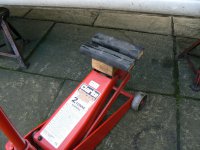
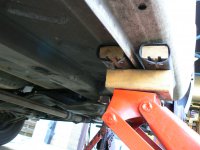
Of course you can equally well just use the car's jack but do be careful as they are well known for being somewhat unstable. Please never get any part of you under a car supported only on a jack!
Having got the car up in the air where do you put the axle stands? The panda has some box sections under the floor which work well. At the rear there is this very handy spot about a foot or so in front of the rear wheel:
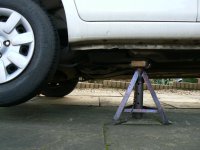
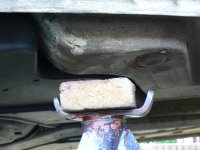
At the front there is a similar point just behind the front wheel arch:
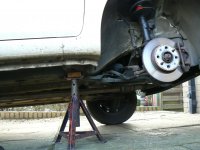
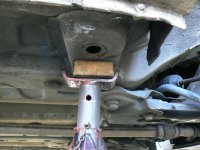
But you might also choose to locate on the front subframe. If using the subframe on any car think carefully about what you are doing or you may bend it. If you look at where I've positioned the stand it's right below where the subframe bolts to the body structure so it's unlikely to bend here.

You'll notice I also put little blocks of wood on the axle stand contact pads? that will stop the stands slipping and also reduce damage to paint and antirust treatments.
NEVER EVER try to support the vehicle on a flat floor panel - footwell etc - it'll definitely bend and might cost "mega bucks" to repair. Also, although tempting as you can get both wheels off the ground in one go, I would never jack up in the middle of a rear axle. Even a slight bend will really mess up the rear geometry.
Hope some of that is helpful?
regards
Jock
PS if your vehicle is getting on a bit in years always remember that rust is like icebergs - at least 90% hidden from view - so what looks to be sound and strong may very well not be! Just take it very slowly and listen for the "rice crispy" noises as the load goes on.
The Ibiza, being so new (coming up on 4 years and 18,000 miles) is, as you would expect, needing little more than a good service and a bit of "fettling". She's already giving up a few "intimate" secrets though, like the air filter having two "pop" on/off rubber grommets underneath where you can't see them! The effect is that they make it feel as if, despite having removed all the fixings, it - the filter casing - still doesn't want to come off. You have to be brave and give it an almighty tug! Now much easier after a light application of silicon grease!
My preferred local factor (SRS) is now supplying Mahle filtration products as well as the Comline they've been doing for some time. I'm very pleased about this and will be using the Mahle filters from now on.
Yesterday I started on Becky (our Panda). The service went well and I was pleased to see that the "dampness" under the rear wheel cylinder dust rubbers has not got any worse. I've already bought new cylinders but as I'm going to have to do pipes as well I'm just hoping it'll all last until the better weather comes. Then, service complete, I went looking for the "clunk" her front suspension has been making for the last couple of weeks. I was suspecting it to be due to an anti roll bar drop link ball joint and she didn't disappoint me. The diagnostic give away was that it clonked most loudly when either front wheel went over a bump, pot hole, etc on it's own but not so much when both wheels went over a bump together (like a "sleeping policeman" for instance). So, right enough, Front end up in the air, - you need to get both front wheel up in the air otherwise, if you just jack up one wheel, the anti roll bar will exert force on the drop links and you won't be able to feel any play in the joints - and there it was O/S/F drop link bottom joint with play in it when you give it a wiggle.
As I was lying on my back thinking "the thread on the bottom bolt looks mighty rusty, might have to take the angle grinder to it" It flashed through mind that, from time to time, people have posted asking how best to support their car whilst working on it. So I thought You might like to see how I support Becky?
I'm fortunate in that I have a nice big trolley jack and I've made up a couple of jacking pads which allow the load to be spread on the sill panels. Still always listen carefully for "crackling" noises and sill deformation during jacking though.


Of course you can equally well just use the car's jack but do be careful as they are well known for being somewhat unstable. Please never get any part of you under a car supported only on a jack!
Having got the car up in the air where do you put the axle stands? The panda has some box sections under the floor which work well. At the rear there is this very handy spot about a foot or so in front of the rear wheel:


At the front there is a similar point just behind the front wheel arch:


But you might also choose to locate on the front subframe. If using the subframe on any car think carefully about what you are doing or you may bend it. If you look at where I've positioned the stand it's right below where the subframe bolts to the body structure so it's unlikely to bend here.

You'll notice I also put little blocks of wood on the axle stand contact pads? that will stop the stands slipping and also reduce damage to paint and antirust treatments.
NEVER EVER try to support the vehicle on a flat floor panel - footwell etc - it'll definitely bend and might cost "mega bucks" to repair. Also, although tempting as you can get both wheels off the ground in one go, I would never jack up in the middle of a rear axle. Even a slight bend will really mess up the rear geometry.
Hope some of that is helpful?
regards
Jock
PS if your vehicle is getting on a bit in years always remember that rust is like icebergs - at least 90% hidden from view - so what looks to be sound and strong may very well not be! Just take it very slowly and listen for the "rice crispy" noises as the load goes on.
Last edited:


